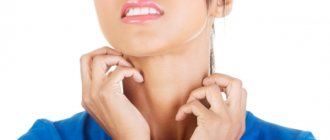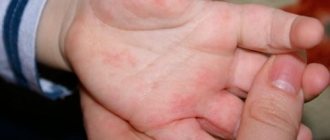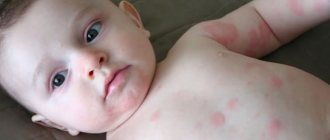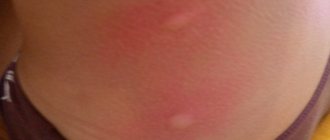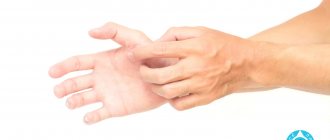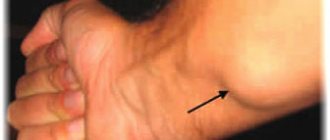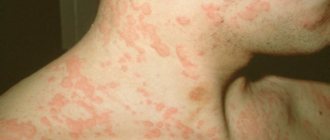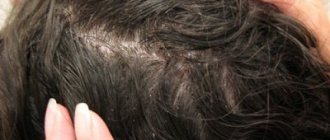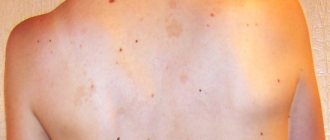Child's temperature
If a child develops a rash on the body, accompanied by itching and fever, you should consult a doctor. In most cases, this condition indicates an infectious disease. Pediatricians recommend treating infectious diseases in a hospital, since the infection quickly spreads throughout the patient’s body and infects others. So, the first thing parents need to do is contact a pediatrician who will establish the correct diagnosis.
Insect bites
Sometimes a rash with fever can be a consequence of the fact that the child has been bitten by some insects, for example, poisonous midges. The increase in temperature will be insignificant. It is due to the fact that the immune system fights the poison that has entered the body, which is why such a reaction can occur. In this case, you will notice that the child is bothered by itching. Your baby will be itchy all the time and appear more restless than usual.
Often, a small rash appears on the body in newly born children. Most often it does not require treatment and soon goes away on its own.
What to do?
Those areas of the body where you see bites can be treated with Psilobalm or Fenistil-gel. They will eliminate the itching. To prevent the appearance of peeling, you can apply a body moisturizer over the medicine, but it is better to do this no earlier than 15 minutes after applying the medicine. If the fever is very high, give your child an antihistamine and some kind of fever-reducing medicine.
Folliculitis: symptoms and causes
This is a type of superficial pyoderma. Skin disease is the result of a purulent-inflammatory process occurring in the hair follicle. The symptoms resemble furunculosis. Only with folliculitis can the temperature rise. In some cases, symptoms similar to ARVI are observed.
Watery eyes, sore throat, cough, rash and fever in an adult may indicate folliculitis. Temperatures can rise to 39 degrees. At the same time, the main difference between the disease and others is the presence of a purulent core in papules and pimples, which can affect any area of the skin on the body. With allergies, chickenpox, lichen and other diseases with similar symptoms, the presence of purulent contents is rare.
Infectious diseases
Infectious diseases such as measles, chickenpox, scarlet fever, rubella are traditionally called childhood diseases. Indeed, they most often occur in childhood. And that's even better. According to doctors, a child’s immune system is more flexible than that of an adult, and therefore it is easier for him to endure a severe infection than a teenager, an elderly person, and especially a pregnant woman. Let's consider what signs can be used to identify a particular disease caused by an infection.
If the rash appears along with a high fever, it is highly likely that the child has an infectious disease
Diagnostic methods
In order to identify the exact causes of rash and fever in an adult, modern dermatology uses the following methods:
- dermatoscopy is a way to examine the affected areas of the skin under a special device that can magnify the object many times without losing image quality;
- fluorescent diagnostics allows using a special apparatus to identify many diseases (in particular, to examine the symptoms of mycoses, dermatoses, vitiligo, leukoplakia, cancer, etc. using an ultraviolet lamp);
- pH-metry of the skin;
- scraping for pathogenic fungi;
- examination of the skin area for demodex, mite components, scabies;
- blood culture for aerobic and anaerobic bacteria;
- culture for cell and tissue morphology;
- biopsy of affected skin areas to identify the cause of the pathology.
Chickenpox
Chickenpox is the most common infectious disease. 85% of the population gets it in childhood. Here are its distinctive features:
- rashes look like blisters filled with liquid;
- in appearance they resemble mosquito bites;
- at first there are few of them, gradually the number increases;
- blisters are located throughout the body: on the head, face, back, stomach and even on the mucous membranes;
- as the disease develops, the blisters shrink, become covered with a crust, which then falls off, leaving no marks on the skin (unless it is deliberately torn off ahead of time);
- the rash is accompanied by itching, so the doctor may prescribe antihistamines;
- The “contagiousness” of chickenpox lasts 2 weeks.
How to relieve itching?
Medications
In pharmacies you can buy various products that relieve itching and moisturize the skin, for example, Advantan. This drug is available in different forms: cream, ointment (oily and regular), as well as emulsion, which means it is possible to choose the most suitable option for each area of the body. So, if the rashes are on the face and you have oily skin, it is better to use a non-greasy ointment. The gel has a lighter structure. If a small rash appears on the neck, where the skin, on the contrary, is dry and sensitive, it is worth purchasing an emulsion or ointment.
You can also lubricate those areas of the body where the rash appears with hydrocortisone ointment. It is used in cases where the rash does not appear due to infection, but for some other reason.
If the cause of the rash is an allergy, then you need to take an antihistamine, for example, Zodak, Tavegil or Suprastin.
Many antiallergic drugs are available not only in the form of tablets, but also in the form of cream, gel or ointment. These options are preferable because... you can apply the product directly to the affected areas.
If there are rashes on the skin in the form of bubbles and blisters, you can dry them with a fucorcin solution.
Traditional methods
Baths with the addition of regular soda help relieve the burning sensation. You can make local baths, for example, if the rashes are localized on your hands, or fill a whole bath with water and soda and lie in it for 15 minutes if the affected areas are more extensive.
Baking soda can also be used to make compresses. In this case, you will need a teaspoon of product per glass of water. Gauze folded in several layers is soaked in the solution, and then the lotion is applied to the affected areas of the skin for 15-20 minutes.
READ ALSO: 3-step program ROYAL SKIN LET IT CO 3-STEP NOSE PACK system for cleaning pores from blackheads - “♫A real fight against blackheads from ROYAL Vic goes on the hunt BEFORE photo! Not a very aesthetic picture♫" | Customer Reviews
Ammonia (1 tablespoon of alcohol and 3 water) can also help eliminate the burning sensation. Apply this solution with a cotton pad. To relieve itching in folk medicine, fermented milk products, fish oil (sold in pharmacies) and tea tree oil are widely used.
Measles
This disease is much less common today than chickenpox because many children are vaccinated against measles. Its features are as follows:
- At first, only fever appears, there are no rashes on the skin.
- But there is conjunctivitis, cough and runny nose, the child becomes lethargic, his malaise is visible, which is why in the first three days measles can be confused with a common cold.
- The rash appears on the third day. At the same time, there is a sharp increase in temperature again.
- First of all, rashes in the form of red pimples appear on the face. Gradually they spread to the chest, stomach, back, arms and legs.
- After 3 days, the pimples disappear, but traces of their presence still remain on the skin: peeling and pigmentation.
Many diseases of an infectious nature are accompanied by the appearance of a rash, high fever and general malaise.
Meningococcal infection
This disease is considered the most dangerous and severe for a child in terms of possible irreversible consequences. The peculiarity of the infection is its rapid progression. The clinical picture looks like this:
- First, a runny nose and a sharp increase in temperature appear;
- muscles and joints experience severe pain that turns into cramps;
- after a couple of hours, a light red rash appears on the body;
- then the acne breaks out, resulting in extensive hemorrhages under the skin.
If such symptoms are detected, you should urgently call an ambulance. Until the medical team arrives, the child must be kept conscious by giving him something to drink. Treatment of wounds with ointments or solutions is excluded.
Rubella
Rubella is a disease that must be suffered in childhood, especially for girls. If you contract this infection during pregnancy, it can lead to serious defects in the development of the fetus. Rubella has the following symptoms:
- rashes without itching are a small rash;
- at the very beginning, the child feels unwell and weak, like during a cold;
- You may feel body aches and have a runny nose;
- the temperature lasts only the first 2 days, after 4-5 days all other symptoms disappear;
- the appearance of a rash is accompanied by pain in the eyes;
- The occipital lymph nodes are enlarged.
Infantile roseola (sudden exanthema)
Herpes virus type 6 (HHV-6) causes roseola infantum (sudden exanthema). Temperatures above 39°C last for 3-4 days, temperatures below 39°C can last up to 8 days. After a drop in temperature, a bright macular or maculopapular rash appears on the skin of the face, neck or torso. The rash does not itch. Sometimes the cervical lymph nodes are enlarged, swelling around the eyes and red papules on the soft palate (Nagayama spots). Fever may be accompanied by diarrhea, cough, runny nose and headache. The rash goes away in 3-4 days without treatment.
Important. The rash that appears after the temperature normalizes is frightening: “First the temperature, and now the rash!” In fact, this is a sign of the end of the disease.
Febrile seizures in children under 2 years of age, fever without a focus of infection, and Epstein-Bar negative mononucleosis are often caused by herpes virus infection type 6 (HHV-6). In rare cases, the virus causes fulminant hepatitis and encephalitis, as well as Rosai-Dorfman syndrome (generalized lymphadenopathy).
Photo. Infantile roseola (sudden exanthema): bright macular and maculopapular rash; herpetic sore throat with ECHO exanthema.
ECHO-exanthema (infectious exanthema) proceeds similarly - the rash appears after the temperature normalizes. With ECHO exanthema, herpetic sore throat and diarrhea are common.
Scarlet fever
You can also read:Acne in children
The causative agent of this disease is streptococcus. Scarlet fever can be distinguished from other infectious diseases by the following characteristics:
- the first symptoms are similar to those that appear with a sore throat: the tonsils become enlarged, the mucous membrane turns red;
- you may notice redness of the tongue (pediatricians call this phenomenon “raspberry tongue”);
- the child feels acute malaise and weakness;
- the rash appears simultaneously with the fever. More often this happens either at the end of the first day or at the beginning of the second;
- the first rash appears on the face, while the nasolabial triangle remains clean, then redness appears on the neck, then spreads throughout the body;
- there are especially many rashes on the inner thighs, in the folds of the skin of the armpits, and on the lower abdomen;
- Symptoms last for a week, but a child is considered contagious for 21 days. At this time he needs to be isolated from society.
Allergy
Allergic reactions are most common in children of the younger and middle age groups, whose bodies have not fully adapted to all foods. A lack of sense of proportion also plays a role, which is why the child eats my sweets. Allergies can be caused by wearing clothes made of synthetic material or detergents. The signs are as follows:
- redness or small rash all over the body;
- unpleasant taste in the mouth;
- in the presence of food poisoning, stool disorders and high fever are added.
In this case, fever and rash are difficult tests for the child. In order to alleviate the condition, he needs to be given activated charcoal, and then put on bed rest. If there is no improvement in the condition after an hour, medical attention is necessary.
A child has a rash and fever: what to do?
If your child has a rash accompanied by fever, diarrhea, and other related symptoms, follow these guidelines:
- Isolate your baby from others. Only one family member should be involved in his treatment.
- There is no need to go to the hospital - the presence of a high temperature is a reason to call a doctor at home, and also prevents infection of others.
- If you are close to pregnant women, do not allow them to come into contact with a sick child.
- Until the doctor arrives, do not treat the rash with any medications, especially dyes: brilliant green, manganese solution, iodine. This may prevent your doctor from making a correct diagnosis.
- If vascular spots appear on the body (they most often appear on the legs), provide the child with bed rest.
- Remember: every infection is fraught with complications, so treatment must be prescribed by a pediatrician.
Rash due to meningococcal infection
Therapy
Treatment for skin rashes with fever depends on the cause of their appearance.
Some rashes with fever may go away without special treatment. For example, rubella, in the treatment of which the main thing is to provide the child with plenty of fluids and place him in a darkened room.
Treatment of scarlet fever, chickenpox and other infectious diseases necessarily includes taking antibiotics. Many diseases are fraught with complications, so it is necessary to adhere to all the specialist’s recommendations and not interrupt therapy when the condition first improves.
Pathologies that are not dangerous in childhood can cause great harm to the fetus if a pregnant woman becomes ill.
Therefore, during the period of planning conception and gestation, contact with infected people should be avoided.
Antihistamines are indicated as an antipruritic agent for allergies and viral infections. It is recommended to lubricate blisters on the skin with brilliant green, fucorcin and other drying substances. For chickenpox, it is useful to take baths with chamomile, string or manganese.
At high temperatures (38-39 °C or more), you need to take antipyretics.
For viral arthritis, painkillers, sometimes glucocorticoids, and bed rest are indicated. The operation is rarely performed.
Thus, there are many causes of fever rashes and it is not always possible to accurately determine them only by symptoms. Therefore, at the first signs of pathology, you should immediately consult a doctor.
Adults who simultaneously experience two symptoms such as high fever (38 C or higher) and skin rash should urgently call an ambulance. The fact is that the simultaneous appearance of a high temperature and a rash can signal a life-threatening condition. Survival rates are significantly higher with aggressive treatment at the onset of these difficult to diagnose diseases. Taken alone, a skin rash and fever may seem mild, but the combination of these symptoms in adults can be a sign of a serious or life-threatening illness. Survival rates increase dramatically in patients who receive prompt, aggressive treatment for the underlying cause of the rash.
People often think that a rash is not a serious symptom, so there are delays in treatment. However, a skin rash in combination with high body temperature (especially in adults!) is clear evidence of an acute systemic disease that requires further diagnosis and urgent treatment. Only early diagnosis and treatment of the disease that causes high fever and rash can quickly prevent death.
Toxic shock syndrome, originally associated with tampon use in the 1980s, remains a major problem. While mortality rates associated with the use of tampons during menstruation have dropped to less than 5%, the rate of toxic shock syndrome has remained relatively unchanged. Cases of toxic shock syndrome in patients following surgery or trauma affect patients of all ages and genders; they are 3 times more likely to be fatal.
Some of the most serious illnesses that are associated with rashes and fever are: Toxic shock syndrome, caused by a bacterial infection Toxic epidermal necrolysis, often caused by drugs Staphylococcal scalded skin syndrome, caused by a bacterial infection Rocky Mountain spotted fever, caused by ticks Meningococcemia, caused by a bacterial infection Fulminant purpura, caused by thrombotic disorders Acute toxic shock syndrome, caused by bacterial infection These diseases are relatively rare and their diagnosis is extremely difficult. Therefore, if symptoms such as high body temperature and rash appear, you need to quickly call an ambulance.
Children often have “mild” viral illnesses that cause skin rashes and are accompanied by high fever. In adults, the combination of these symptoms requires rapid diagnosis. After all, these dangerous diseases can be treated in the early, most curable stages.
There are many factors that cause red spots to appear on a child's body. This may be due to a dangerous infectious or viral disease, allergies, or a common insect bite. Almost always, the rash is accompanied by hyperthermia, which indicates a protective reaction of the baby. Red spots on a child’s body and elevated temperature are a significant reason for a visit to the pediatrician, because some diseases can be very difficult for a weak child’s body to tolerate.
Treatment
The presence of a rash accompanied by a high temperature is a reason to consult a pediatrician. In this case, you should not self-medicate, just as you should not leave everything to chance. If rubella, in principle, does not require special treatment and goes away on its own, then scarlet fever, on the contrary, without taking antibiotics is fraught with complications that will primarily affect the baby’s kidneys and heart. Any disease of infectious etymology should develop under medical supervision.
When the rash is accompanied by an increase in temperature, we can talk about a serious infectious disease, the development of which must necessarily occur under the supervision of a pediatrician. However, a rash with fever may also be a manifestation of an allergy or a consequence of the child being bitten by insects. Pay attention to general symptoms and, if treatment is necessary, discuss it with your doctor.
Symptoms and possible causes of red spots in adults
The appearance of red spots on the body is considered a very common problem among adults. The reasons for such trouble can be varied: in the field of dermatology, there are more than five dozen diseases in which red spots are one of the symptoms. Such a skin problem can signal the presence of a pathology if the formation begins to itch, peel, or increase in size and quantity. If such manifestations often “visit” you, then you should contact a dermatologist to identify the causes and prescribe adequate treatment.
Redness that is itchy and does not itch
Many diseases occur in humans due to increased nervous excitability. Red spots on the body are no exception, and itching appears due to various disorders. The redness itself can be the cause of weakened vascular tone. To reduce the appearance of red spots to a minimum, to reduce the area of their localization, it is necessary to take a contrast shower, play sports, and carry out other procedures aimed at strengthening blood vessels and immunity. This disorder is called vegetative and does not pose a health hazard.
If the red spots are caused by an infectious infection, then along with the itching, catarrhal phenomena, fever, and intoxication syndrome appear. As a result of the infection, inflammation is observed, which has a special location; erosion, spots with crusts, purulent or watery contents may appear. Among the most common causes of red spots are: meningitis, scarlet fever, measles, chicken pox, and typhoid fever. Red spots can be caused by a fungal infection, the most common of which is contagious ringworm.
The next cause of red spots with itching on the body is considered to be photodermatosis. This is a disease that has another name: sun allergy. Ultraviolet radiation causes redness, rash, and swelling. In case of severe itching, you should take antiallergic medications that will reduce redness and relieve irritating sensations. In the warm season, you need to wear closed clothes, go out into direct sunlight less often, avoid tanning, and use creams with SPF protection of at least 25.
The chronic disease atopic dermatitis causes the described trouble. It manifests itself as red spots, itching, peeling, and skin thickening, which appear in most cases during the cold season and disappear in the summer. To eliminate symptoms, hormonal ointments and antiallergic drugs help.
With psoriasis, rashes on the body, red spots can be very massive and bother you for a long time. In many cases, they appear on the knees, elbows, lower back, buttocks, and other extensor surfaces of the body. Skin manifestations can grow, merge with each other, and cause severe peeling. Treatment should only be prescribed by a doctor.
Red spots that do not cause any additional sensations such as irritation, itching, do not go away on their own, are located on the skin of the chest, arms, legs, and other parts of the body indicate problems with the liver, digestive, and vegetative-vascular systems. Poor functioning of the internal organs makes itself felt in the form of redness of different sizes and shapes. In this case, you should not guess about the reasons, self-medicate, but go to a specialist for a consultation.
Coverage area
If erythema suddenly appears throughout the body, then we are talking about an allergy, which is called urticaria. For treatment, it is necessary to identify the allergen, eliminate it, and take antihistamines, otherwise the condition may result in anaphylactic shock. Red spots can appear as a result of strong emotional and physical stress. If such skin changes are flaky, this may indicate psoriasis. In addition, the causes may be infectious diseases, scleroderma, when the vessels cannot withstand the stress and burst.
When a red spot appears after taking a shower or bath on the neck or chest, this may indicate hives, allergies to water, gels, shampoos, soaps used, substances used to disinfect tap water. In addition, such skin disorders appear as a result of vegetative-vascular dystonia, when the vessels cannot respond normally to external changes (high humidity, hot water, high ambient temperature).
When red spots are localized on the neck in the absence of itching, this indicates pityriasis versicolor, which is treated by dousing with acidified water, hardening procedures, and antifungal ointments. The next reason is atopic dermatitis, which is accompanied by itching of the lesion due to disturbances in the gastrointestinal tract.
Red spots localized on the palms may indicate the presence of more than 8 dozen diseases. In most cases, these are scabies, allergies, palmar erythremia. Only a doctor should make an accurate diagnosis. The appearance of redness on the chest indicates a hormonal imbalance, illness of internal organs, allergies to foods or external irritants.
Red spotting of the hands indicates lichen, another infectious, viral disease. In addition, such changes in the skin of the extremities can be provoked by poor nutrition with a predominance of fatty, floury, fried foods, smoked foods, sweets, stress, and emotional excitability.
The location of red spots in the head area indicates seborrheic dermatitis due to the proliferation of a special type of fungus, which is facilitated by hormonal changes. The causative agent of the disease becomes active in the cold season, under stress. Seborrhea is accompanied by peeling, the appearance of dense yellow scales, and itching.
The concentration of red spots on the face is divided into three types: rosacea, which is accompanied by the appearance of dilated small vessels of a permanent or temporary nature; erythrosis, characterized by permanent or temporary redness of the nose and cheeks; rosacea, which is a combination of rosacea, erythrosis, inflammatory phenomena in the form of papules, pustules. Find out how rosacea on the face is treated.
Pityriasis rosea - round, rough rashes on the skin
In most cases, this disease occurs in people 20-40 years old. The first symptoms are weakness, malaise, increased body temperature, and swollen lymph nodes. Afterwards, red spots appear, localized to the shoulders, chest, back, sides, and thighs. In many cases, they disappear without a trace, but it is better not to ignore the disease, otherwise eczema, staphyloderma, and streptoderma may join it. Treatment of pityriasis rosea is aimed at minimizing the risk of complications.
Allergy to alcohol
Red spots on the body that appear after drinking alcohol may indicate the onset of an allergy to alcohol. First the face turns red, then the rest of the body. This disease is considered to be an increased individual sensitivity to a certain substance, upon repeated exposure to which the body begins to produce antibodies to fight it, resulting in an inflammatory process with unpredictable consequences. Allergies can be caused by ethyl alcohol, yeast, hops, synthetic dyes, preservatives, and flavorings.

